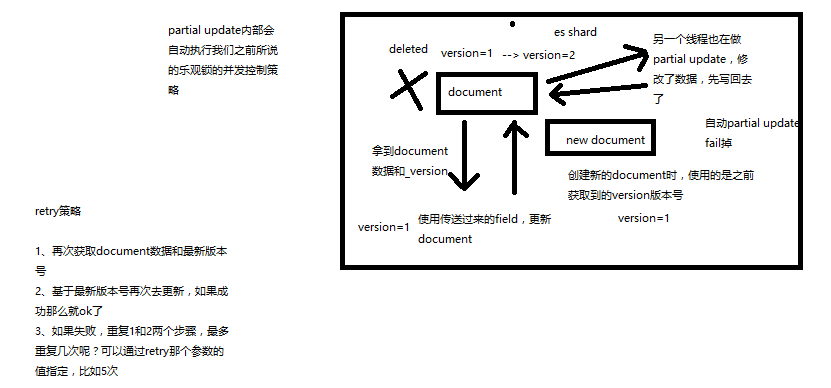一.partial update
1、什么是partial update?
PUT /index/type/id,创建文档&替换文档,就是一样的语法
一般对应到应用程序中,每次的执行流程基本是这样的:
(1)应用程序先发起一个get请求,获取到document,展示到前台界面,供用户查看和修改
(2)用户在前台界面修改数据,发送到后台
(3)后台代码,会将用户修改的数据在内存中进行执行,然后封装好修改后的全量数据
(4)然后发送PUT请求,到es中,进行全量替换
(5)es将老的document标记为deleted,然后重新创建一个新的document
partial update
post /index/type/id/_update
{
"doc": {
"要修改的少数几个field即可,不需要全量的数据"
}
}
看起来,好像就比较方便了,每次就传递少数几个发生修改的field即可,不需要将全量的document数据发送过去
2、图解partial update实现原理以及其优点
partial update,看起来很方便的操作,实际内部的原理是什么样子的,然后它的优点是什么

3、上机动手实战演练partial update
PUT /test_index/test_type/10
{
"test_field1": "test1",
"test_field2": "test2"
}
POST /test_index/test_type/10/_update
{
"doc": {
"test_field2": "updated test2"
}
}
二.mget
1、批量查询的好处
就是一条一条的查询,比如说要查询100条数据,那么就要发送100次网络请求,这个开销还是很大的
如果进行批量查询的话,查询100条数据,就只要发送1次网络请求,网络请求的性能开销缩减100倍
2、mget的语法
(1)一条一条的查询
GET /test_index/test_type/1
GET /test_index/test_type/2
(2)mget批量查询
GET /_mget
{
"docs" : [
{
"_index" : "test_index",
"_type" : "test_type",
"_id" : 1
},
{
"_index" : "test_index",
"_type" : "test_type",
"_id" : 2
}
]
}
{
"docs": [
{
"_index": "test_index",
"_type": "test_type",
"_id": "1",
"_version": 2,
"found": true,
"_source": {
"test_field1": "test field1",
"test_field2": "test field2"
}
},
{
"_index": "test_index",
"_type": "test_type",
"_id": "2",
"_version": 1,
"found": true,
"_source": {
"test_content": "my test"
}
}
]
}
(3)如果查询的document是一个index下的不同type种的话
GET /test_index/_mget
{
"docs" : [
{
"_type" : "test_type",
"_id" : 1
},
{
"_type" : "test_type",
"_id" : 2
}
]
}
(4)如果查询的数据都在同一个index下的同一个type下,最简单了
GET /test_index/test_type/_mget
{
"ids": [1, 2]
}
3、mget的重要性
可以说mget是很重要的,一般来说,在进行查询的时候,如果一次性要查询多条数据的话,那么一定要用batch批量操作的api
尽可能减少网络开销次数,可能可以将性能提升数倍,甚至数十倍,非常非常之重要
三.bulk
1、bulk语法
POST /_bulk
{ "delete": { "_index": "test_index", "_type": "test_type", "_id": "3" }}
{ "create": { "_index": "test_index", "_type": "test_type", "_id": "12" }}
{ "test_field": "test12" }
{ "index": { "_index": "test_index", "_type": "test_type", "_id": "2" }}
{ "test_field": "replaced test2" }
{ "update": { "_index": "test_index", "_type": "test_type", "_id": "1", "_retry_on_conflict" : 3} }
{ "doc" : {"test_field2" : "bulk test1"} }
每一个操作要两个json串,语法如下:
{"action": {"metadata"}}
{"data"}
举例,比如你现在要创建一个文档,放bulk里面,看起来会是这样子的:
{"index": {"_index": "test_index", "_type", "test_type", "_id": "1"}}
{"test_field1": "test1", "test_field2": "test2"}
有哪些类型的操作可以执行呢?
(1)delete:删除一个文档,只要1个json串就可以了
(2)create:PUT /index/type/id/_create,强制创建
(3)index:普通的put操作,可以是创建文档,也可以是全量替换文档
(4)update:执行的partial update操作
bulk api对json的语法,有严格的要求,每个json串不能换行,只能放一行,同时一个json串和一个json串之间,必须有一个换行
{
"error": {
"root_cause": [
{
"type": "json_e_o_f_exception",
"reason": "Unexpected end-of-input: expected close marker for Object (start marker at [Source: org.elasticsearch.transport.netty4.ByteBufStreamInput@5a5932cd; line: 1, column: 1])\n at [Source: org.elasticsearch.transport.netty4.ByteBufStreamInput@5a5932cd; line: 1, column: 3]"
}
],
"type": "json_e_o_f_exception",
"reason": "Unexpected end-of-input: expected close marker for Object (start marker at [Source: org.elasticsearch.transport.netty4.ByteBufStreamInput@5a5932cd; line: 1, column: 1])\n at [Source: org.elasticsearch.transport.netty4.ByteBufStreamInput@5a5932cd; line: 1, column: 3]"
},
"status": 500
}
{
"took": 41,
"errors": true,
"items": [
{
"delete": {
"found": true,
"_index": "test_index",
"_type": "test_type",
"_id": "10",
"_version": 3,
"result": "deleted",
"_shards": {
"total": 2,
"successful": 1,
"failed": 0
},
"status": 200
}
},
{
"create": {
"_index": "test_index",
"_type": "test_type",
"_id": "3",
"_version": 1,
"result": "created",
"_shards": {
"total": 2,
"successful": 1,
"failed": 0
},
"created": true,
"status": 201
}
},
{
"create": {
"_index": "test_index",
"_type": "test_type",
"_id": "2",
"status": 409,
"error": {
"type": "version_conflict_engine_exception",
"reason": "[test_type][2]: version conflict, document already exists (current version [1])",
"index_uuid": "6m0G7yx7R1KECWWGnfH1sw",
"shard": "2",
"index": "test_index"
}
}
},
{
"index": {
"_index": "test_index",
"_type": "test_type",
"_id": "4",
"_version": 1,
"result": "created",
"_shards": {
"total": 2,
"successful": 1,
"failed": 0
},
"created": true,
"status": 201
}
},
{
"index": {
"_index": "test_index",
"_type": "test_type",
"_id": "2",
"_version": 2,
"result": "updated",
"_shards": {
"total": 2,
"successful": 1,
"failed": 0
},
"created": false,
"status": 200
}
},
{
"update": {
"_index": "test_index",
"_type": "test_type",
"_id": "1",
"_version": 3,
"result": "updated",
"_shards": {
"total": 2,
"successful": 1,
"failed": 0
},
"status": 200
}
}
]
}
bulk操作中,任意一个操作失败,是不会影响其他的操作的,但是在返回结果里,会告诉你异常日志
POST /test_index/_bulk
{ "delete": { "_type": "test_type", "_id": "3" }}
{ "create": { "_type": "test_type", "_id": "12" }}
{ "test_field": "test12" }
{ "index": { "_type": "test_type" }}
{ "test_field": "auto-generate id test" }
{ "index": { "_type": "test_type", "_id": "2" }}
{ "test_field": "replaced test2" }
{ "update": { "_type": "test_type", "_id": "1", "_retry_on_conflict" : 3} }
{ "doc" : {"test_field2" : "bulk test1"} }
POST /test_index/test_type/_bulk
{ "delete": { "_id": "3" }}
{ "create": { "_id": "12" }}
{ "test_field": "test12" }
{ "index": { }}
{ "test_field": "auto-generate id test" }
{ "index": { "_id": "2" }}
{ "test_field": "replaced test2" }
{ "update": { "_id": "1", "_retry_on_conflict" : 3} }
{ "doc" : {"test_field2" : "bulk test1"} }
2、bulk size最佳大小
bulk request会加载到内存里,如果太大的话,性能反而会下降,因此需要反复尝试一个最佳的bulk size。一般从1000~5000条数据开始,尝试逐渐增加。另外,如果看大小的话,最好是在5~15MB之间。